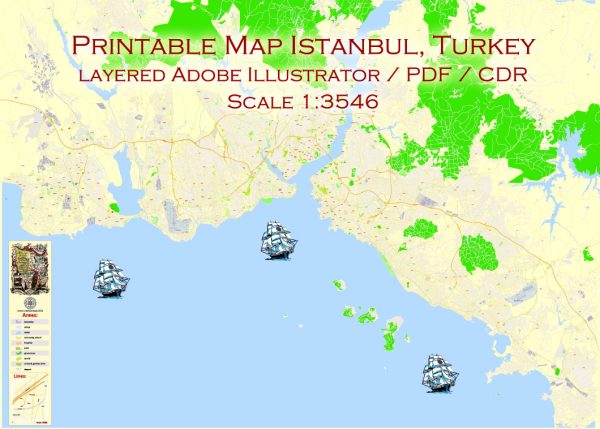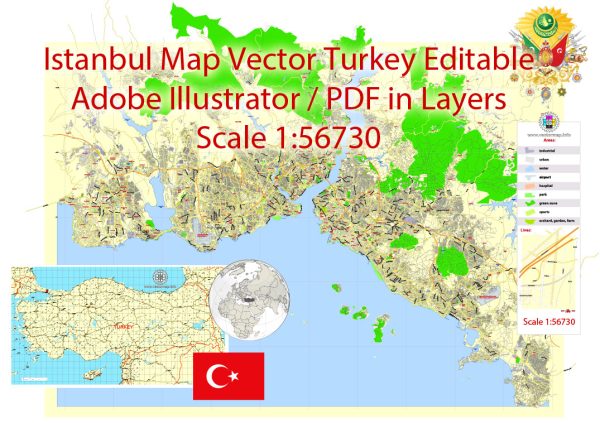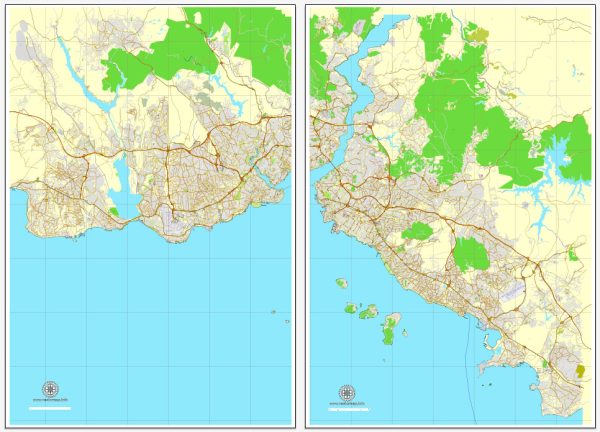Istanbul, historically known as Byzantium and later Constantinople, has a rich history that spans over two millennia. Its strategic location at the crossroads of Europe and Asia has made it a significant center for trade, culture, and politics. The city’s transportation infrastructure has evolved over the centuries to meet the changing needs of its inhabitants and the demands of its role as a major hub.
Vectormap.Net provide you with the most accurate and up-to-date vector maps in Adobe Illustrator, PDF and other formats, designed for editing and printing. Please read the vector map descriptions carefully.
Historical Overview:
- Ancient Period (660 BC – 330 AD): The city was founded by Greek colonists around 660 BC. It later became the capital of the Eastern Roman Empire (Byzantine Empire) in 330 AD, after Emperor Constantine the Great moved the capital from Rome.
- Byzantine Period (330 AD – 1453 AD): During this era, Constantinople flourished as a major center of trade, culture, and learning. The city’s strategic location on the Silk Road and its control over key trade routes facilitated its economic prosperity.
- Ottoman Period (1453 AD – 1922 AD): The Ottoman Turks, led by Mehmed II, conquered Constantinople in 1453, marking the end of the Byzantine Empire. The city then became the capital of the Ottoman Empire. The Ottomans expanded and improved the city’s infrastructure, including its transportation networks.
- Modern Period (1923 AD – Present): After the fall of the Ottoman Empire, Istanbul became part of the Republic of Turkey in 1923. The city continued to grow and modernize under the leadership of Mustafa Kemal Atatürk.
Transportation Infrastructure:
- Historical Roads: In ancient times, Byzantium was connected to important Roman roads. The construction of the Mese (main street) during the Roman period and its subsequent expansions in the Byzantine and Ottoman eras played a crucial role in the city’s transportation.
- Aqueducts: The Byzantines and later the Ottomans built aqueducts to supply water to the city. The Valens Aqueduct, completed in the 4th century, is one of the notable examples.
- Ottoman Era Bridges: The Ottomans built several bridges across the Golden Horn, a natural harbor dividing the European and Asian sides of the city. The most famous is the Galata Bridge, initially constructed in the 19th century and rebuilt several times.
- Railways: The introduction of railways in the 19th century brought significant changes to Istanbul’s transportation. The Orient Express, connecting Istanbul to European capitals, played a crucial role in facilitating international travel.
- Ferries and Shipping: Due to its location on the Bosporus Strait, Istanbul has a long history of maritime transportation. Ferries and boats have been vital for connecting the European and Asian sides of the city.
- Modern Transportation (20th Century – Present): Istanbul has expanded its transportation infrastructure significantly in recent decades. The city now has an extensive network of roads, bridges, tunnels, and public transportation options, including buses, trams, metro lines, and a funicular.
- Bosphorus Bridges and Tunnels: The construction of the Bosphorus Bridges (Bosphorus Bridge and Fatih Sultan Mehmet Bridge) and the Marmaray Tunnel in the late 20th and early 21st centuries has further improved connectivity between the European and Asian sides of Istanbul.
In summary, Istanbul’s transportation infrastructure has evolved from ancient roads and aqueducts to modern highways, bridges, and tunnels, reflecting the city’s historical significance and its role as a major metropolis at the crossroads of continents.




 Author: Kirill Shrayber, Ph.D.
Author: Kirill Shrayber, Ph.D.